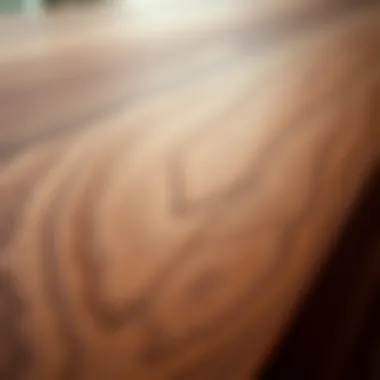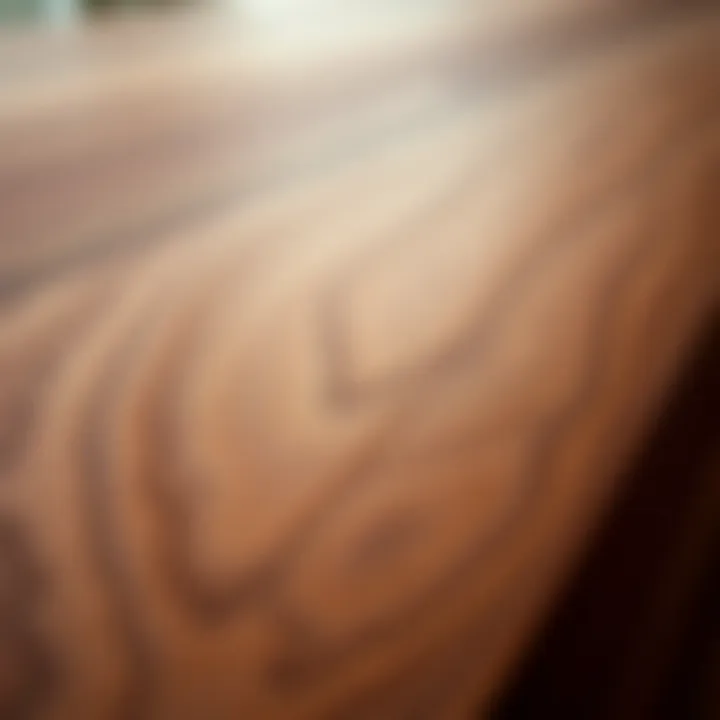Exploring Black Walnut Veneer: Features and Uses


Intro
In recent years, the allure of black walnut veneer has captured the imagination of both designers and DIY enthusiasts alike. This material, known for its rich tones and unique grain patterns, transcends basic functionality by blending beauty with practicality. As homeowners seek ways to infuse warmth and sophistication into their spaces, black walnut stands out as a material choice that does not fade into the background. It’s not just about aesthetics; it's about durability and versatility.
With the increasing focus on sustainable practices, the appeal of black walnut veneer is further enhanced. It invites a dialogue on responsible sourcing, allowing consumers to enjoy its beauty without compromising their values. To explore this further, let’s peel back the layers and discuss current furniture trends, delve into DIY projects, and lastly, understand care tips that will help maintain the elegance of black walnut veneer.
The goal here is to empower individuals—whoever they may be, whether a novice DIYer or an established designer—to appreciate and utilize this remarkable material. Understanding how to incorporate it into home decor, while considering sustainability, is pivotal in today’s market. Let's dive into this exploration of black walnut veneer and uncover why it deserves a place in your projects and your home.
Prelude to Black Walnut Veneer
Black walnut veneer has established itself as a staple in the world of furniture design due to its unique combination of beauty, durability, and versatility. This material, sourced from the American black walnut tree, is more than just a pretty face; it’s a product rooted in tradition, craftsmanship, and sustainability, making it a favorite choice for homeowners, designers, and DIYers alike.
The significance of understanding black walnut veneer lies in its diverse applications and the thoughtful choices involved in selecting the right pieces for projects. For those seeking to elevate their interior spaces, recognizing the nuances of black walnut veneer can mean the difference between a good design and an exceptional one. Its rich color and intricate grain invite admiration, while its strength assures longevity, bridging functionality with aesthetic appeal.
As we dive deeper into the characteristics and applications of black walnut veneer, it becomes evident just how pivotal this material is in modern design. Selecting this veneer means investing in not only striking beauty but also sustainability and care. Homeowners can appreciate the warmth it brings into any room, while designers can utilize its adaptable nature in furniture and décor settings.
"Veneer is not just a material; it’s an art form that can transform spaces with warmth and elegance."
Understanding black walnut veneer also plays a vital role in encouraging ethical sourcing practices. As more consumers push for transparency in the materials they choose, knowing where and how black walnut is sourced can influence purchasing decisions. In this context, awareness of sustainable practices will be discussed, shedding light on responsible use without sacrificing luxury or style.
In the sections to follow, we will break down the essential characteristics of black walnut veneer, including its visual aesthetics, grain patterns, and practical applications in furniture design. The article will also touch on the care and maintenance required to preserve the beauty and integrity of this exquisite material. Whether you're outfitting a cozy home or working on a design project, insights gleaned from these discussions can inform better choices, ultimately enhancing the spaces where we live and work.
Characteristics of Black Walnut Veneer
The characteristics of black walnut veneer play a pivotal role in elevating its status in furniture design and home décor. This section delves into the unique features that set black walnut apart, ensuring that homeowners, designers, and DIY enthusiasts grasp its multifaceted benefits.
Visual Aesthetics
When it comes to appearance, black walnut veneer has always been a head-turner. Its rich, warm tones ranging from creamy white to deep chocolate brown create a visual spectacle. The natural luster of the wood, especially when polished, draws attention and provides a sense of sophistication. You might say it has a way of "stealing the show" in any room.
The grain patterns, often swirling and intricate, add an element of organic artistry. Each piece of veneer tells its own story, marked by subtle differences in color and texture. This can lead homeowners to feel that they are not merely purchasing a material but investing in a unique work of art. The depth and richness of its appearance don’t just amplify aesthetics; they also provide warmth and comfort, making spaces feel more inviting.
"The beauty of black walnut veneer is not just skin deep; it’s a blend of visual appeal and tactile experience, making it a favored choice in modern and traditional settings alike."
Durability and Strength
Durability in veneer is crucial, and black walnut does not disappoint. Renowned for its strength, it can withstand the wear and tear of everyday use without showing significant signs of aging. This wood type has a Janka hardness rating that places it among the harder varieties, which means it can handle a bit of roughhousing—an important factor if you have an active household. This sturdiness translates into longevity, allowing furniture made from black walnut veneer to be both beautiful and stable throughout the years.
Additionally, the natural oils present in black walnut offer an inherent resistance to decay and pests, ensuring it stands the test of time without needing constant care or replacement. This makes it an excellent choice for both indoor and outdoor applications.
Grain Patterns and Color Variations
The grain patterns and color variations in black walnut veneer enhance its appeal significantly. From straight grains to more elaborate, wavy designs, each piece can have its own character, which is part of what makes this veneer appealing to designers. The unique formations of these grains can influence the final look of the furniture, creating everything from a classic vibe to a contemporary feel.
Color variations also come into play here, as you might spot pieces that have hints of purples and subtle greens alongside the traditional browns. These unexpected hues can serve as delightful surprises to the discerning eye, allowing for diversified design outcomes. When selecting walnut veneer for projects, being mindful of these features can help creators choose pieces that align precisely with their vision and aesthetic goals.
Benefits of Using Black Walnut Veneer
Black walnut veneer stands out not just for its beauty but also for its many practical benefits. This section delves into the significance of using black walnut veneer, focusing on its cost-effectiveness and sustainable sourcing. By understanding these facets, designers and homeowners alike can make informed decisions about integrating this classic material into their projects.
Cost-Effectiveness
When talking about value, black walnut veneer really shines. Unlike solid hardwood, which can come with hefty price tags, veneered products are more accessible for those working with tight budgets. Veneers offer the same high-end look as solid wood but at a fraction of the cost. This makes it a go-to choice for designers and DIY enthusiasts who want elegant pieces without mortgaging their homes.
A few aspects that underscore the cost-effectiveness of black walnut veneer are:
- Material Efficiency: Using veneer reduces waste. The thin slices can cover larger surfaces, maximizing the usable wood from a single log.
- Lower Labor Costs: Working with veneers often requires less labor-intensive techniques than solid wood, saving both time and money during the building process.
- Durability: Black walnut veneer can be made quite durable with proper finishes, extending the lifespan of furniture and reducing the need for replacements.
"Opting for black walnut veneer not only enhances aesthetics but also keeps the wallet happy."


Sustainable Sourcing
In today’s world, where environmental concerns are at the forefront, sustainable sourcing is a crucial consideration for any material. Black walnut veneer supports responsible forestry practices, especially when sourced from certified suppliers who prioritize sustainability. This means that consumers can enjoy the luxury of walnut without feeling guilty about harming the environment.
Here’s why sustainable sourcing of black walnut veneer is essential:
- Forest Management: Ethical sourcing practices usually involve selective logging. This allows trees that are too young to be wood but encourages biodiversity by maintaining the health of the forest ecosystem.
- Regeneration: Responsible suppliers often replant trees to replace those harvested, ensuring forests continue to thrive for generations.
- Certification: Look for certifications like the Forest Stewardship Council (FSC). These licenses indicate that the wood comes from forests that are responsibly managed, socially beneficial, and environmentally sound.
By choosing black walnut veneer from sustainable sources, it's possible to beautify a home while contributing positively to ecological balance. This aligns perfectly with modern values of responsibility and mindfulness in consumption.
Integrating black walnut veneer into design projects not only results in visually stunning interiors but also fosters a commitment to sustainability. Whether you're a homeowner or a designer, understanding these benefits can help in creating spaces that resonate with ethical choices and enduring quality.
Learn more about sustainable forestry practices at FSC official website and explore the impact of ethical sourcing in furniture design on platforms like Britannica.
Applications of Black Walnut Veneer in Furniture Design
The applications of black walnut veneer in furniture design are vast and varied, contributing to not just the aesthetic allure but also the practical functionality of a myriad of pieces. This material, sought after for its rich tones and unique grain patterns, can transform ordinary furniture into works of art. Designers and homeowners alike can harness its properties to create pieces that not only serve a purpose but breathe life into spaces.
Cabinetry and Built-Ins
Cabinetry and built-ins made from black walnut veneer exhibit elegance and durability. Whether it’s a sleek kitchen design or an inviting living room built-in, walnut adds a touch of class while maintaining strength. The veneer allows for intricate designs and can be shaped into unique forms that solid wood might not accommodate. For instance, combining a walnut veneer with lighter woods can create striking contrast, highlighting the richness of the walnut.
When selecting cabinetry, consider the grain. Bookmatched panels create a mirror effect with the grains flowing into each other, adding visual intrigue. This approach is not only stylish but also functional, as it can strategically hide seams. Furthermore, built-in designs can maximize storage while elevating the personal style; the warmth of walnut draws families together, making common spaces feel more inviting.
Table Tops and Desks
Tabletops crafted from black walnut veneer bring to the forefront elegance married with resilience. Used in dining tables or home offices, the veneer provides ample surface area while showcasing the wood's natural beauty. The inviting depth of walnut's color lends an air of sophistication to any dining experience.
Moreover, the smooth finish of walnut veneer ensures that spills can be easily wiped away, which is a significant practical consideration for surfaces that are heavily used. For desks, walnut veneer brings together functionality and aesthetics. It allows for elaborate designs that can include curved edges or inset features without compromising on strength.
"The blend of form and function in walnut veneer tables makes them favorites among designers and homeowners looking to create long-lasting impact in their spaces."
Accents and Decorative Panels
The versatility of black walnut veneer extends to accents and decorative panels, which can redefine an entire room. Whether as wall coverings or as elements within furniture, the rich, dynamic appearance of walnut can capture attention without being overwhelming. For instance, using walnut panels as a feature wall can add depth and warmth to contemporary interiors, creating a focal point that speaks to organic elegance.
Moreover, walnut accents can be used in conjunction with other materials, such as metal or glass, to create a striking contrast. These applications are not just about looks; they can influence how spaces are experienced, fostering an atmosphere that feels modern yet timeless. Whether as drawer fronts or bookshelf backing, these touches enhance the design language significantly.
In sum, the applications of black walnut veneer in furniture design touch on essential aspects of style, sustainability, and practicality. As this material continues to gain momentum in the realm of interior design, its inherent qualities ensure that it remains a sought-after choice for creating evergreen, captivating environments.
Selecting Black Walnut Veneer for Projects
When looking to enhance a project with black walnut veneer, there are critical factors to consider. This choice isn't merely about picking a pretty layer of wood; it's about selecting the right material for your specific needs. Understanding what sets this veneer apart not only helps in achieving aesthetic goals but also ensures that the final product stands the test of time.
Assessing Quality and Grading
Quality and grading are paramount when selecting black walnut veneer. Higher grades indicate fewer defects, better grain patterns, and more consistent color. Here’s what to keep in mind:
- Defect Evaluation: Inspect for knots, blemishes, and other imperfections. A clean veneer means less hassle in finishing.
- Grain Clarity: Each sheet of black walnut is unique. The grain should be pronounced and appealing. Look for straight, tight grain that indicates high quality.
- Uniformity: Consistency in color and grain is essential for a polished look. Ask for samples when possible to compare different sheets.
- Manufacturer Standards: Different manufacturers have varying grading systems. Familiarize yourself with them to ensure you’re getting what you pay for. For instance, grades like "A" or "AA" typically denote higher quality.
Choosing the Right Thickness
The thickness of your black walnut veneer is another consideration that significantly influences the final appearance and application. Here are the considerations to take into account:


- Project Type: Thicker veneers are ideal for surfaces that will endure regular use, like tabletops or cabinetry where durability is key. Conversely, thin veneer works well for decorative accents, bending applications, or intricate designs.
- Application Method: The adhesion process can vary based on thickness. Thicker veneers may require specialized adhesives or techniques to ensure they bond properly without warpage.
- Finishing Needs: Thicker pieces provide more surface area for sanding and finishing, allowing for a smoother final result. If your design involves a highly polished finish, opting for a thicker veneer can make a substantial difference.
- Weight Consideration: Thicker veneers can add weight to your project; ensure that your underlying structure can support it.
In summary, selecting black walnut veneer is a deliberate process, requiring careful consideration of quality and thickness. When aimed at achieving remarkable results, delve into these details to harness the beauty of this exquisite wood.
Preparing Black Walnut Veneer for Use
When it comes to working with black walnut veneer, the preparation phase is vital for achieving a high-quality end result. The techniques applied during preparation can heavily influence how the veneer behaves during application and beyond. Proper cutting, joining, and adhesion methods are crucial components that can enhance the aesthetic and structural integrity of the finished product.
Cutting Techniques
Cutting black walnut veneer requires foresight and skill. When preparing to slice the veneer, precision is key. A skilled hand can make all the difference. Here are some crucial tips for cutting:
- Tools of the Trade: Using a sharp utility knife or a veneer saw ensures clean edges. Dull blades can tear the delicate fibers, leading to unsightly results.
- Measured Approach: Always measure twice before cutting. It’s better to take your time and ensure accuracy rather than rushing and making errors.
- Grain Direction: Pay attention to the grain pattern. Cutting against the grain can create splinters and an uneven surface. Following the grain will allow for smoother edges and easier finishing.
- Safety First: Wear protective gear, such as goggles and gloves, when cutting. This will protect you from accidents while handling sharp tools.
Joining and Adhesion Methods
Once cut, the next step involves how to join pieces of black walnut veneer together or adhere them to a substrate. This step is equally crucial as improper joining can lead to warping or delamination later. Here’s what to consider:
- Types of Adhesives: Opt for high-quality adhesives designed for wood, like PVA (polyvinyl acetate) or urea-formaldehyde. These provide a strong bond that can withstand the test of time.
- Preparation of Surfaces: Ensure both surfaces being joined are clean and dry. Any debris or moisture can compromise adhesion.
- Clamping is Crucial: Use clamps to apply even pressure during drying. This not only ensures a tight bond but also prevents air bubbles from forming under the veneer.
- Considerations for Movement: Wood naturally expands and contracts with humidity. When joining, it’s wise to leave a small gap around the veneer edges. This allows for natural movement without causing issues like warping or cracking.
Preparing black walnut veneer effectively involves careful attention to detail from cutting to joining. Each step adds up to create an impressive final product, prized for both its beauty and functionality. Proper preparation can save time and resources down the line, making it all the more worthwhile. By mastering these techniques, you're setting the groundwork for durable and visually appealing projects that truly showcase the splendor of black walnut veneer.
"Good preparation prevents poor performance."
For additional references on veneer techniques, visit Wikipedia or consult wood working communities on Reddit.
Understanding these aspects is essential for both aspiring and experienced craftsmen alike, ensuring that their work not only meets their expectations but also stands the test of time.
Finishes Suitable for Black Walnut Veneer
Selecting the right finish for black walnut veneer is crucial, as it not only enhances the beauty of the wood but also ensures longevity and resilience. The finishes applied serve to protect the material from moisture, stains, and wear, all while highlighting its unique grain and color variations. Understanding the different types of finishes available can greatly aid homeowners, designers, and DIYers in making informed decisions that align with their specific needs.
Natural Oils and Waxes
Natural oils and waxes are popular choices for those looking to maintain the authentic and natural appearance of black walnut veneer. Products like tung oil or linseed oil penetrate deep into the wood, nourishing it from within while offering a degree of water resistance. These oils not only protect but also enhance the grain, giving the surface a warm, rich look. Generally, finishing with oil follows these key benefits:
- Enhanced Grain Visibility: Natural oils tend to bring out the grain patterns much more dramatically than some other finishes, which can cover and obscure the natural beauty.
- Environmental Safety: Many natural oils and waxes are considered eco-friendly. They contain fewer volatile organic compounds (VOCs), making them safer for indoor use.
- Ease of Application: For DIYers, applying oil finishes can be straightforward. They can be wiped on with a cloth, with less risk of error compared to more complex finish types.
- Ease of Repair: If the finish becomes damaged, reapplication is often as simple as cleaning the surface and adding more oil, without the need for sanding.
However, oil finishes typically require more frequent maintenance than polyurethanes or lacquers. They may not offer the same level of protection against scratches and heavy wear. Users have to weigh aesthetics against durability quite carefully.
Lacquers and Varnishes
On the other hand, lacquers and varnishes provide a tougher, more durable finish, making them ideal for high-use surfaces like tabletops and cabinetry. Lacquer offers a hard shield that can withstand spills and scratches, which can be a boon for active households. Varnishes, particularly those with a urethane base, deliver a protective layer that not only enhances durability but also maintains clarity, letting the rich colors of black walnut shine through. Key attributes of lacquers and varnishes include:
- High Gloss Options: Lacquers often come in high-gloss formulations, adding a shine that accentuates the deep hues in walnut.
- Durability: These finishes are exceptionally resilient against water, heat, and chemicals, making them suitable for kitchen and bathroom applications.
- Quick Drying: Unlike oils, lacquers dry quickly, allowing for quicker project completion. This can be particularly advantageous for furniture makers who need to finish pieces rapidly.
- Variety of Sheens: Varnishes and lacquers can be tailored to achieve various sheens, from matte to semi-gloss, accommodating different design aesthetics.
However, there are trade-offs. Lacquer can be tricky to apply; it can develop an uneven finish if not applied correctly. Additionally, both lacquers and varnishes contain some solvents that may emit odors during application, which can be unpleasant without adequate ventilation.
"Choosing the right finish for your black walnut veneer can make all the difference between a mundane piece and a striking statement in your home."
Maintaining Black Walnut Veneer
Maintaining black walnut veneer is crucial for preserving its natural beauty and ensuring durability. This type of veneer, known for its rich color and intricate grain patterns, can become dull and damaged without proper care. Understanding the value of maintenance goes beyond mere aesthetic appeal; it enhances longevity and functionality, which is especially important for homeowners and designers investing in quality materials. Regular upkeep not only keeps furniture looking fresh but also reinforces the overall value of your pieces.


Cleaning and Care Procedures
When it comes to cleaning black walnut veneer, a gentle approach is always best. Harsh chemicals can strip away the finish and mar the wood. Here are some effective cleaning strategies:
- Dust Often: Use a soft, lint-free cloth to wipe away dust regularly. This simple step prevents buildup that can dull the finish over time.
- Mild Soap Solution: For deeper cleans, mix a few drops of mild dish soap with water. Dampen a cloth with this solution, wringing it out well, and gently wipe the surface. Avoid soaking the wood, as too much moisture can lead to warping.
- Drying Immediately: After wiping, always follow up with a dry cloth to remove any remaining moisture. This practice helps avoid water spots and keeps the veneer intact.
- Avoid Heat: Be mindful of where you place hot items. Use coasters or trivets to protect the surface from heat damage, which can cause discoloration.
"Regular cleaning isn’t just about appearance; it’s about maintaining the integrity of the wood itself."
Repairing Dents and Scratches
Dents and scratches can happen, even with the most careful users. Repairing them early can prevent further damage. Here are some techniques to consider:
- Iron Method for Dents: For small dents, place a damp cloth over the area and gently run a warm iron over it. The steam helps the wood swell back into shape. Be cautious not to leave the iron in one spot for too long.
- Scratch Concealers: If you're dealing with scratches, you might want to use a wood repair marker or a touch-up pen that matches the color of your veneer. Simply apply it to the scratched area and blend it in for a seamless look.
- Natural Solutions: Some swear by using a walnut half to rub onto scratches. The natural oils of the walnut can sometimes help mask the mark, though this method is less reliable.
- Final Finishing Touches: After repairs, it’s wise to re-apply a suitable finish or polish to restore consistency across the surface. Ensure any product used is compatible with your existing finish to avoid issues.
Maintaining black walnut veneer is not merely a chore; it is an investment in the longevity and beauty of your furniture. Whether you’re a DIY enthusiast or an architect designing graceful spaces, understanding the nuances of care can significantly enhance the life cycle and charm of your veneer pieces.
Sustainability and Ethical Considerations
In today's world, as we become more conscious of environmental issues, the topic of sustainability and ethical practices in material sourcing has taken center stage. This aspect is especially crucial when it comes to timber products like black walnut veneer. Homeowners, designers, and DIY enthusiasts are increasingly seeking materials that not only enhance aesthetics but also adhere to sustainable practices. The demand for ethically sourced materials holds significant value, impacting both consumers and the environment positively.
Sourcing Black Walnut Ethically
When discussing the sourcing of black walnut, ethical considerations come to the forefront. Ethical sourcing encompasses obtaining materials in a way that respects the environment and local communities. Key elements of ethical sourcing include:
- Responsible Harvesting: This refers to logging practices that ensure forests are managed sustainably. For black walnut, this means cutting only mature trees while leaving younger ones, allowing for natural regeneration.
- Certification: Look for wood products that carry certifications like FSC (Forest Stewardship Council) or PEFC (Programme for the Endorsement of Forest Certification). These certifications guarantee that the wood meets stringent environmental and social standards.
- Support Local Economies: Purchasing from local suppliers can bolster communities and reduce the carbon footprint associated with transportation.
By sourcing black walnut ethically, consumers can contribute to a market that values sustainability while enjoying the rich beauty of the wood.
Environmental Impact of Walnut Harvesting
The environmental impact of walnut harvesting is a complex issue that deserves attention. Here are several considerations regarding this topic:
- Deforestation Concerns: Overharvesting can lead to deforestation, which in turn affects biodiversity and contributes to climate change. Protecting forests should be a priority, as these ecosystems offer numerous benefits, including carbon sequestration and habitat for wildlife.
- Soil Erosion: Clear-cutting can result in soil erosion and degradation, affecting water quality in nearby streams and rivers. Sustainable logging practices mitigate these risks by preserving areas of forest and maintaining soil health.
- Carbon Footprint: The transportation of black walnut from forests to end-users can increase carbon emissions. Utilizing local resources or certified sources can help lessen this impact.
"The sustainability of our precious resources, like black walnut, relies on our commitment to ethical practices in sourcing and harvesting."
In summary, consumers can play a pivotal role in promoting sustainability. By choosing ethically sourced black walnut veneer, they can not only enjoy its unique beauty but also contribute to the well-being of our planet and future generations. This holistic approach to furniture design reflects a growing awareness and responsibility towards environmental stewardship.
Future Trends in Black Walnut Veneer Usage
The exploration of future trends in black walnut veneer usage is significant not only for those who appreciate fine woodworking, but also for those concerned about sustainability and innovation in design. As the furniture industry evolves, black walnut veneer stands at the forefront due to its ability to blend aesthetic appeal with ethical sourcing. Understanding these trends can provide insights into how we approach design and craftsmanship.
Innovations in Veneer Technology
Technological advancements continue to reshape the way black walnut veneer is produced and utilized. Modern techniques allow for thinner sheets while maintaining strength and flexibility. For instance, the use of laser cutting technology enables complex designs that were previously difficult to achieve. These innovations can reduce waste significantly, making the production process more eco-friendly.
Furthermore, digital printing technologies can now apply intricate patterns and colors directly onto veneers, opening avenues for customization. This means a decorative surface no longer has to rely solely on the natural grain, giving designers and homeowners a broader palette to work with. In many ways, these innovations have made black walnut veneer accessible to a larger audience, still retaining the luxurious feel it is known for.
By merging craftsmanship with technology, we are redefining what’s possible with black walnut veneer.
Emerging Design Trends
As the interior design landscape transforms, so does the role of black walnut veneer in various applications. Key emerging trends include:
- Sustainable Furniture: There’s a growing demand for eco-conscious designs. This means more designers are gravitating toward sustainably sourced black walnut, which aligns perfectly with consumer values.
- Biophilic Design: As people become more aware of their surroundings, natural elements are making a comeback in homes and offices. Black walnut, with its warm tones and organic appearance, embodies this movement beautifully.
- Mixing Materials: The trend of combining materials is gaining traction. Pairing black walnut with metals, glass, or even concrete brings forth a striking contrast that appeals to modern aesthetics.
Staying aware of these trends is crucial for renters, homeowners, and designers looking to make informed choices in their furniture selections. The marriage of tradition and innovation in black walnut veneer ensures it remains relevant, appealing to those seeking both style and substance.
The future of black walnut veneer is not just about maintaining its classic charm; it’s also about evolving to meet new expectations and challenges. By embracing these trends, the furniture industry can continue to honor the natural beauty of this material while promoting sustainable practices.















